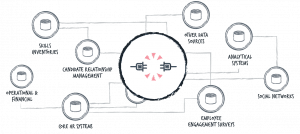Despite investing more than US$20 billion in HR technology over the last five years to improve the digital management of people resources, many larger organizations still struggle to access information needed for faster insights and more informed decision-making. According to the most recent Deloitte Global Human Capital Trends survey, 65 percent of respondents reported that their HR technology was inadequate or only fair at achieving its overall objectives.
For HR practitioners and business managers, many of these challenges stem from people analysis issues due to data that is poorly integrated and governed. Here are some signs that this may be the case in your organization:
- Limited insight when making strategic staffing decisions
- Struggling to innovate and retain talent
- Keeping up with changing regulatory and privacy requirements is a chore
If your business is facing any (or all) of these challenges, or would benefit from moving more quickly, then you will want to keep reading. In this post, you’ll discover why this happens and how a large multinational manufacturing company is using a data hub from MarkLogic to overcome these challenges.
The Root Cause: Fragmented HR Data Silos
Many IT functions, in an attempt to help HR functions quickly address administrative inefficiencies, have invested in multiple software systems and applications to enable better employee and manager self-service and HR reporting. This has resulted in a systems architecture full of disconnected technical and data silos, as shown in diagram below.

Unfortunately, even after installing these applications, consumers of HR data (e.g., HR practitioners, managers, data scientists, and developers) still struggle to easily find the data they need to manage the growing people demands of their businesses. For example, finding employees that have the skills, knowledge, interests, and availability to support short-term innovation projects can often require the time-consuming assembly of information from multiple systems or sources, forcing stretched HR staff to waste valuable time and effort.
Based on our experience, these ongoing challenges are typically rooted in systems and processes used to integrate, curate, and harmonize these fragmented HR systems and datasets. HR systems, and the people that use them, are only as effective as the data that feeds the information applications.
Bottlenecks often occur when data sources need to be added or updated, harmonized with other data, and quickly made available to downstream HR systems. Newer data sources often include new schemas or unstructured data formats, and don’t fit easily with traditional relational models and integration approaches. This is where using a data hub, powered by a multi-model database, provides the most flexible and scalable approach for integrating all HR data, while meeting enterprise requirements for security and transactional consistency.
Optimizing HR Data Architecture With a Data Hub
Meeting business demands for greater organizational effectiveness starts with a reliable view of your workforce, including full-time and part-time employees, contractors, and candidates, as well as details about assignments and job requirements. Accessing a unified 360-degree view of this people data is foundational for performing analysis and building better HR applications, but getting that reliable view is a major challenge for most organizations. Not surprising, since larger organizations can have up to 75 different HR and business systems, and a typical HR department has more than 400 data elements about each employee.
This is why large companies with the need to modernize their data architectures in order to handle new and changing data requirements have employed the MarkLogic Data Hub Platform.
Case Study: Creating 360° View of Your Employees With Integrated GDPR Compliance
Already an existing customer, a major multinational manufacturing company with over 130,000 employees wanted a 360° view of all people data to better serve business units and employees, and to meet General Data Protection Regulation (GDPR) requirements. Strong pressure was put on IT to give the HR business management a clear view of employee data, benefits, payrolls, personal evaluations, and a modern approach to handle GDPR.
With the MarkLogic Data Hub, the company was able to quickly build a portal to discover information about skill, appraisal, certification, salary for their people, and support GDPR compliance for all employee data. As importantly, the Data Hub platform now allows the manufacturer to serve all of the curated HR data through a secure API self-service layer for various business requests.
In using a MarkLogic Data Hub, the manufacturer addressed all of its business requirements and pain points, including:
- Optimizing an expensive and inefficient ERP system architecture consisting of hundreds of interfaces for over a hundred applications
- Flexibility and governance to address analytics, regulations, and reporting in the cloud
- Ability to handle growing HR data and other data volume increases without performance issues
- Improvement in HR data quality, traceability, and protection of personal data
- Reduce over-reliance on ERP vendor, i.e., vendor lock-in
With more agile, documented and secure HR data processes, developers are now able to more effectively build new applications and address changing business requirements. With a unified 360° view of its people for faster insights, HR is now able to play more of an advisory role in helping digitally transform the company.
Deliver Faster Value From Your HR Data With the MarkLogic Data Hub Platform
Organizational effectiveness requires a single data platform that enables faster time-to-results by providing your data operations with all capabilities necessary to deliver a more reliable view of HR data for improved developer productivity.
As the world’s best data platform for integrating data from silos, MarkLogic is trusted by leading organizations to deliver faster value from their HR data. With the simplicity of one fully integrated platform built for the cloud, data can be loaded as-is, enriched, and harmonized faster and more cost-effectively than traditional methods.
Learn More
To learn how a MarkLogic Data Hub can enable your company to overcome HR data silos for improved people insights and organizational effectiveness, please read HR Departments: Your Employee Data Deserves Better.

Ed Downs
Ed Downs is responsible for customer solutions marketing at MarkLogic. He draws on his considerable experience, having delivered large-scale big data projects and operational and analytical solutions for public and private sector organizations, to drive awareness and accelerate adoption of the MarkLogic platform.

